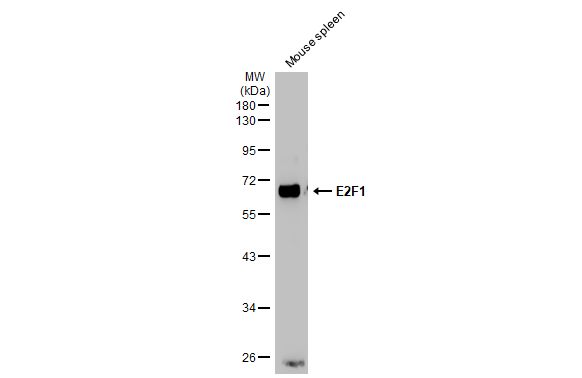| Weight | 1 lbs |
|---|---|
| Dimensions | 9 × 5 × 2 in |
| host | mouse |
| isotype | IgG1 |
| clonality | monoclonal |
| concentration | 1 mg/mL |
| applications | ICC/IF, WB |
| reactivity | E2F-1 |
| available sizes | 100 µg |
mouse anti-E2F-1 monoclonal antibody (2F10) 8037
$503.00
Antibody summary
- Mouse monoclonal to E2F-1
- Suitable for: WB,IHC-P,IP
- Isotype: IgG1
- 100 µg
mouse anti-E2F-1 monoclonal antibody (2F10) 8037
| antibody |
|---|
| Tested applications WB,IHC,IHC,IP |
| Recommended dilutions Immunoblotting: use at 1-5 ug/mL. Immunoprecipitation: use at 1-5 ug/mL. Positive controls: E2F-1 transfected Soas2 cells and recombinant fusion protein. |
| Immunogen GST fusion protein expressed in E. coli corresponding to aa 162-476 of human E2F-1. |
| Size and concentration 100µg and lot specific |
| Form liquid |
| Storage Instructions This antibody is stable for at least one (1) year at -70°C. Avoid multiple freeze- thaw cycles. |
| Storage buffer PBS, pH 7.4 |
| Purity protein affinity purification |
| Clonality monoclonal |
| Isotype IgG1 |
| Compatible secondaries goat anti-mouse IgG, H&L chain specific, peroxidase conjugated polyclonal antibody 5486 goat anti-mouse IgG, H&L chain specific, biotin conjugated, Conjugate polyclonal antibody 2685 goat anti-mouse IgG, H&L chain specific, FITC conjugated polyclonal antibody 7854 goat anti-mouse IgG, H&L chain specific, peroxidase conjugated polyclonal antibody, crossabsorbed 1706 goat anti-mouse IgG, H&L chain specific, biotin conjugated polyclonal antibody, crossabsorbed 1716 goat anti-mouse IgG, H&L chain specific, FITC conjugated polyclonal antibody, crossabsorbed 1721 |
| Isotype control Mouse monocolonal IgG1 - Isotype Control |
| target relevance |
|---|
| Protein names Transcription factor E2F1 (E2F-1) (PBR3) (Retinoblastoma-associated protein 1) (RBAP-1) (Retinoblastoma-binding protein 3) (RBBP-3) (pRB-binding protein E2F-1) |
| Gene names E2F1,E2F1 RBBP3 |
| Protein family E2F/DP family |
| Mass 46920Da |
| Function FUNCTION: Transcription activator that binds DNA cooperatively with DP proteins through the E2 recognition site, 5'-TTTC[CG]CGC-3' found in the promoter region of a number of genes whose products are involved in cell cycle regulation or in DNA replication (PubMed:10675335, PubMed:12717439, PubMed:17050006, PubMed:17704056, PubMed:18625225, PubMed:28992046). The DRTF1/E2F complex functions in the control of cell-cycle progression from G1 to S phase (PubMed:10675335, PubMed:12717439, PubMed:17704056). E2F1 binds preferentially RB1 in a cell-cycle dependent manner (PubMed:10675335, PubMed:12717439, PubMed:17704056). It can mediate both cell proliferation and TP53/p53-dependent apoptosis (PubMed:8170954). Blocks adipocyte differentiation by binding to specific promoters repressing CEBPA binding to its target gene promoters (PubMed:20176812). Directly activates transcription of PEG10 (PubMed:17050006, PubMed:18625225, PubMed:28992046). Positively regulates transcription of RRP1B (PubMed:20040599). {ECO:0000269|PubMed:10675335, ECO:0000269|PubMed:12717439, ECO:0000269|PubMed:17050006, ECO:0000269|PubMed:17704056, ECO:0000269|PubMed:18625225, ECO:0000269|PubMed:20040599, ECO:0000269|PubMed:20176812, ECO:0000269|PubMed:28992046, ECO:0000269|PubMed:8170954}. |
| Subellular location SUBCELLULAR LOCATION: Nucleus {ECO:0000269|PubMed:20040599, ECO:0000269|PubMed:28992046}. |
| Structure SUBUNIT: Component of the DRTF1/E2F transcription factor complex. Forms heterodimers with DP family members. The E2F1 complex binds specifically hypophosphorylated RB1, the interaction represses E2F1-driven transcription (PubMed:8336704). During the cell cycle, RB1 becomes phosphorylated in mid-to-late G1 phase, detaches from the DRTF1/E2F complex, rendering E2F transcriptionally active. Viral oncoproteins, notably E1A, T-antigen and HPV E7, are capable of sequestering RB1, thus releasing the active complex. Interacts with TRRAP, which probably mediates its interaction with histone acetyltransferase complexes, leading to transcription activation. Binds TOPBP1 and EAPP. Interacts with ARID3A. Interacts with TRIM28; the interaction inhibits E2F1 acetylation through recruiting HDAC1 and represses its transcriptional activity. Interaction with KAT2B; the interaction acetylates E2F1 enhancing its DNA-binding and transcriptional activity. Interacts with BIRC2/c-IAP1 (via BIR domains). The complex TFDP1:E2F1 interacts with CEBPA; the interaction prevents CEBPA binding to target genes promoters and represses its transcriptional activity (PubMed:20176812). Interacts with RRP1B (PubMed:20040599). Interacts with HCFC1 (PubMed:23629655). Interacts with KMT2E; the interaction is probably indirect and is mediated via HCFC1 (PubMed:23629655). Interacts with DCAF5 and L3MBTL3; the interaction requires methylation at Lys-185 and is necessary to target E2F1 for ubiquitination by the CRL4-DCAF5 E3 ubiquitin ligase complex (PubMed:29691401). {ECO:0000250|UniProtKB:Q61501, ECO:0000269|PubMed:10675335, ECO:0000269|PubMed:11418595, ECO:0000269|PubMed:12598654, ECO:0000269|PubMed:12697828, ECO:0000269|PubMed:15716352, ECO:0000269|PubMed:16360038, ECO:0000269|PubMed:17704056, ECO:0000269|PubMed:20040599, ECO:0000269|PubMed:20176812, ECO:0000269|PubMed:21653699, ECO:0000269|PubMed:23629655, ECO:0000269|PubMed:29691401, ECO:0000269|PubMed:8336704, ECO:0000269|PubMed:9780002}.; SUBUNIT: (Microbial infection) Interacts with human cytomegalovirus/HHV-5 protein UL123. {ECO:0000269|PubMed:7494286}. |
| Post-translational modification PTM: Phosphorylated by CDK2 and cyclin A-CDK2 in the S-phase (PubMed:12717439, PubMed:7838523). Phosphorylation at Ser-364 by CHEK2 stabilizes E2F1 upon DNA damage and regulates its effect on transcription and apoptosis (PubMed:12717439). Phosphorylation at Ser-403 by GSK3B promotes interaction with USP11, leading to its deubiquitination and stabilization (PubMed:28992046). {ECO:0000269|PubMed:12717439, ECO:0000269|PubMed:28992046, ECO:0000269|PubMed:7838523}.; PTM: Ubiquitinated via 'Lys-63'-linked ubiquitin, leading to its degradation (PubMed:28992046). Deubiquitinated by USP11 following phosphorylation by GSK3B, promoting its stability (PubMed:28992046). {ECO:0000269|PubMed:28992046}.; PTM: Acetylation stimulates DNA-binding. Enhanced under stress conditions such as DNA damage and inhibited by retinoblastoma protein RB1. Regulated by KAP1/TRIM28 which recruits HDAC1 to E2F1 resulting in deacetylation. Acetylated by P/CAF/KAT2B. {ECO:0000269|PubMed:10675335, ECO:0000269|PubMed:17704056}.; PTM: Methylation at Lys-185 by SETD7 promotes E2F1 ubiquitin-dependent proteasomal degradation. {ECO:0000269|PubMed:20603083, ECO:0000269|PubMed:29691401}. |
| Target Relevance information above includes information from UniProt accession: Q01094 |
| The UniProt Consortium |
Data
Publications
| pmid | title | authors | citation |
|---|---|---|---|
| We haven't added any publications to our database yet. | |||
Protocols
| relevant to this product |
|---|
| Western blot IHC |
Documents
| # | SDS | Certificate | |
|---|---|---|---|
| Please enter your product and batch number here to retrieve product datasheet, SDS, and QC information. | |||
Only logged in customers who have purchased this product may leave a review.











Reviews
There are no reviews yet.